Strategic Marketing Plan | How to Grow Your Small Business
Strategic marketing plans are incredibly important for successfully achieving your marketing goals.
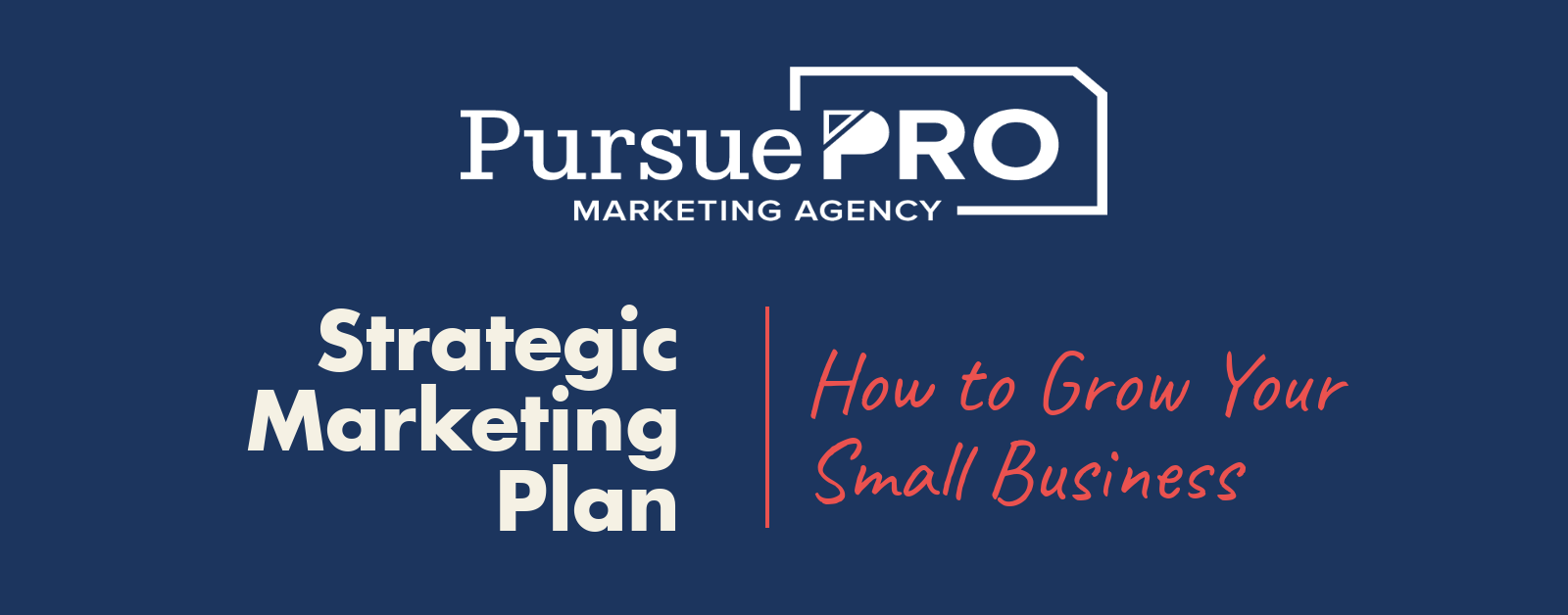
Have you ever found yourself trying to wrap your head around what a true marketing strategy for your business would look like?
Often times small business owners and entrepreneurs struggle with the concept of marketing or understand only bits and pieces. Marketing is much more than simply advertising or branding and it doesn’t have to be difficult to apply it to your business. This article will help you see a clear picture of what marketing should look like for your business, and how to make your very own strategic marketing plan.
What is a Strategic Marketing Plan?
- Strategic Marketing Plan
- A plan that positions your business in the marketplace, optimizes your sales funnel, and maximizes the value created in the goods exchange process.
As you can see in the definition, there are three stages of a Strategic Marketing Plan:
-
Positioning– Determining how and where you take your stance in the marketplace.
-
Sales Funnel – Where you create a plan that maximizes your lead capturing, lead nurturing, and lead conversion efforts.
-
Goods Exchange – This stage helps you obtain the most value possible from the exchange of goods between you and the customer, for your future benefit.
Why does every business and entrepreneur need to have a Strategic Marketing Plan?
1. A compass to move all facets of a company in a unified direction – much like a Mission Statement or Core Values. The Positioning Stage is primarily used for this reason.
2. A tool to map out your advertising campaign efforts, and to make sure that all efforts support the overarching plan. The Sales Funnel Stage is primarily used for this reason.
3. A policy for key systems that are vital in creating the most amount of value in the goods exchange process.
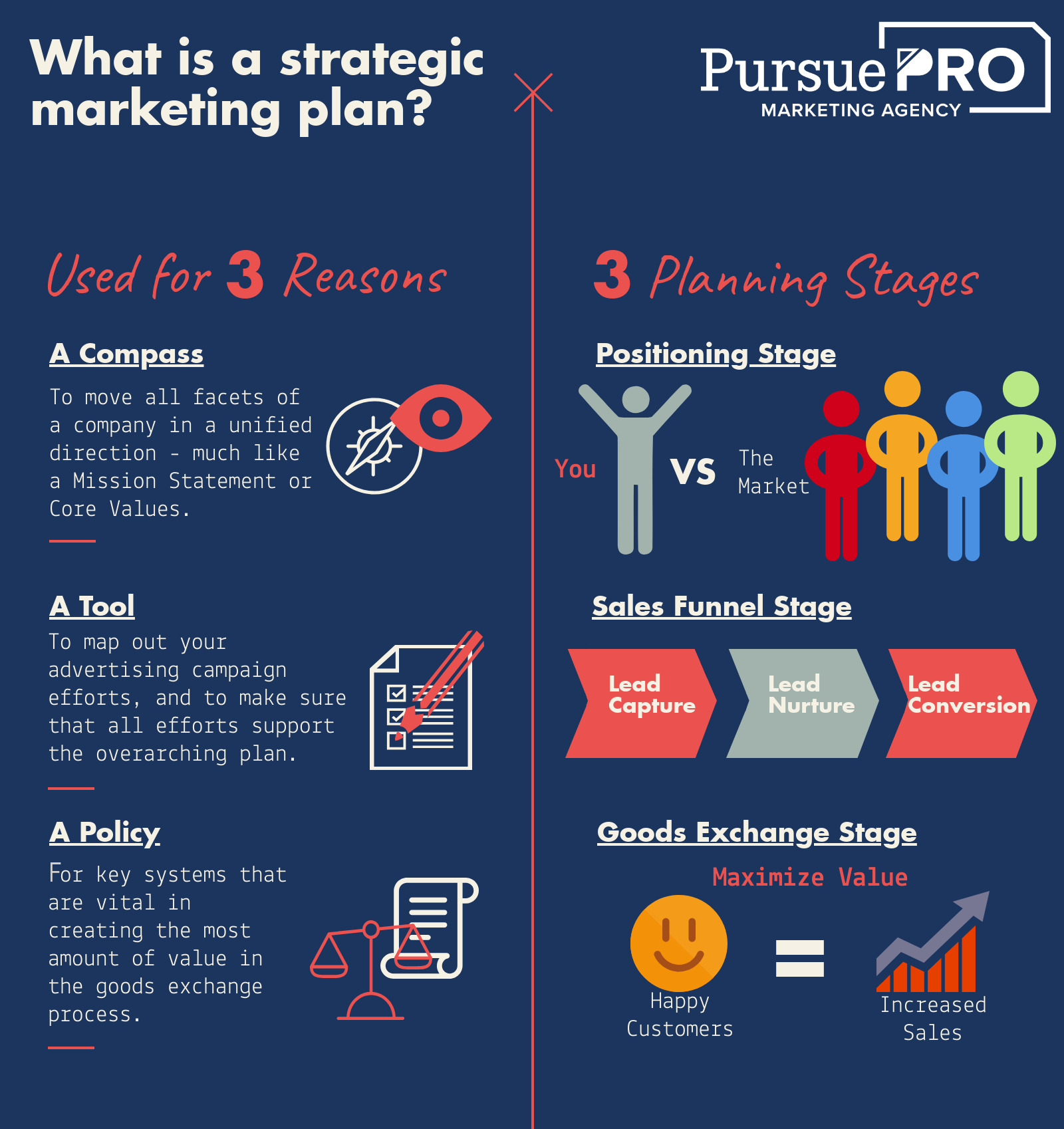
When should I use a Strategic Marketing Plan?
Every business should have a marketing plan in place before even entering the marketplace. I know that most small businesses do not initially do this; in fact, some long standing business often have neglected this step as well. The bottom line is if you do not want to be squeezed out by your competition or you want to maximize your advertising ROI, every business should absolutely have a strategic marketing plan.
Once you initially create a strategic marketing plan, you should review and update your strategic marketing plan every time you are about to spend money on promoting some facet of your business. Whether you are hiring to fill a position, promoting a new product, or raising brand awareness in a local community, make sure you review and update your Strategic Marketing Plan. Treat it as a living document and keep it up to date with all your promotion efforts to have a clear picture as to whether they are aligned in supporting the overarching plan.
How to Create a Strategic Marketing Plan:
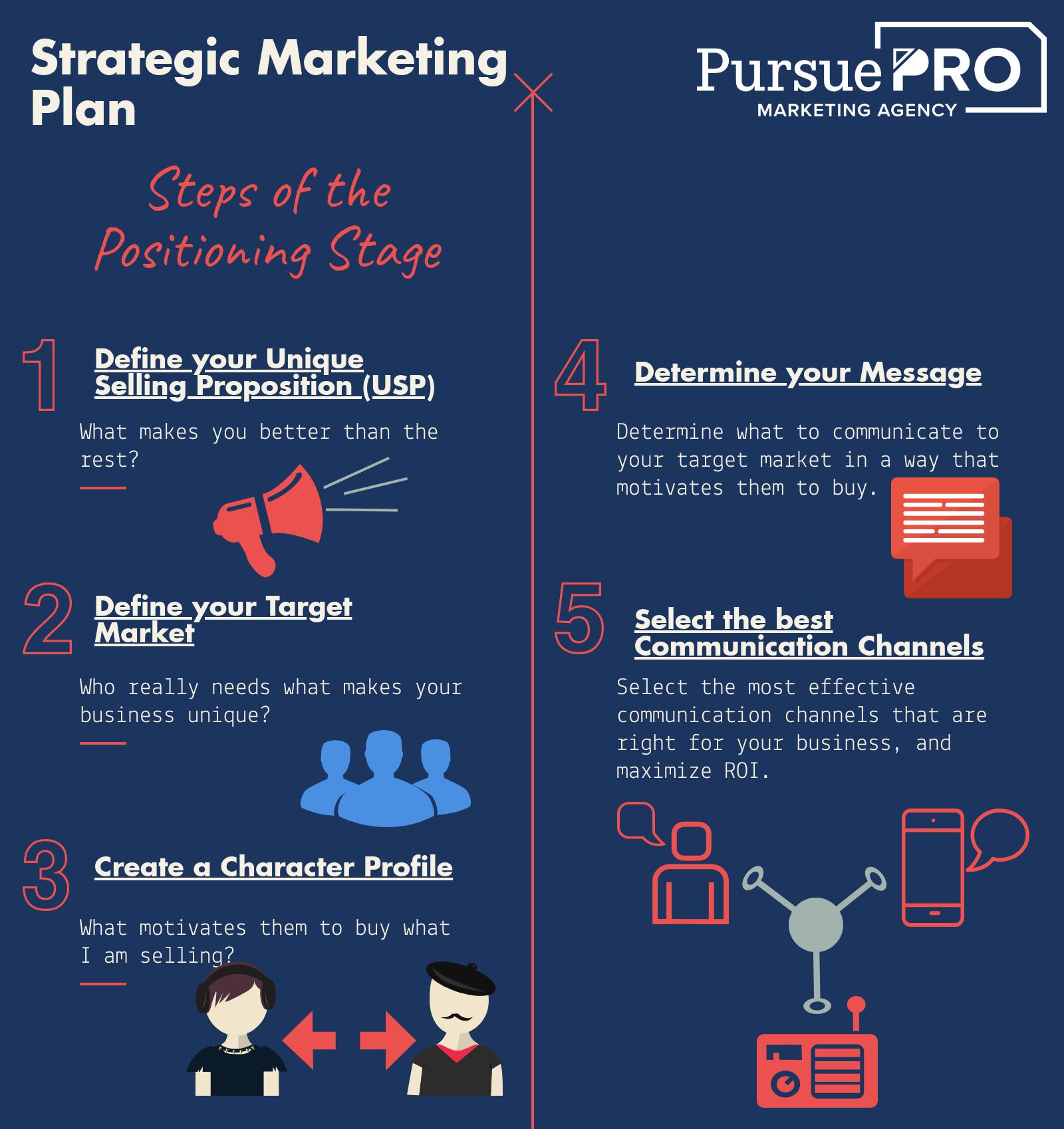
Positioning stage:
The positioning stage is arguably the most important part of a strategic marketing plan. If you position your company for success in the marketplace, all your other marketing efforts will come much easier. Additionally, the positioning stage is also one of the more difficult areas to plan for your business. It will make you answer the big questions that can be hard to make a decision on. It will be the backbone of everything else making it the area you should make sure you get right. Take your time in this area but don’t get stuck on it. It is always better to have a plan and realize later it needs to change, than to not have a plan and have no idea if you are succeeding or failing.
1. Define your Unique Selling Proposition (USP).
A unique selling proposition is one of those things that force you to be brutally honest with yourself. My grandfather was always a great advocate of this practice. When he heard I was starting a marketing agency he asked, “Why should I spend my money with you and not the guy who has a lower price?” After I gave what I thought to be a pretty good answer he followed with, “How are you going to convince me of that?”… His questions are exactly the ones we need to answer. Communicate to people what makes your business unique and better than your competitors.
*Read this article if you want to learn more about How to create a USP.*
2. Determine who needs your USP. AKA Define your Target Market.
What type of person needs what makes you unique? By narrowing in on a certain target market, you can create a message that is specifically catered to what the person needs to hear. Small business owners often make this statement, “My product/service is for everyone. Why would I want to limit my advertising to a small group of people rather than reaching everyone?” If your goal is to increase profits, you want your advertising to be effective at converting consumers into customers. The advertisements that are best at converting sales are the ones that best capture what motivates a particular consumer to buy. The most effective way at creating an advertisement that speaks specifically to what motivates a consumer, is to select a target market and keep it focused. It is easier to motivate a specific group with similar interests than a large group with diverse interests.
Mass Marketing is only an alternative to the Target Market approach if you have an enormous amount of money to invest into advertisements. Most small to medium sized businesses are not positioned well to use a mass marketing approach.
3. List out the Character Profile of your Target Market.
Once you have pinpointed a target market, it is now time to walk in their shoes. This is a very important point in the process and makes good marketing campaigns become great. Answer the question, “What motivates this person to buy what I am selling.” You need to pretend you’re the customer (sometimes literally) in order to feel certain emotions or wants that they might feel. Next you need to list personality traits / characteristics / needs / desires / behavioral patterns / and any other key identifiers that the individual might have.
4. Determine your Message to your Target Market.
This is the point where you take your character profile and determine how to best communicate your unique selling proposition. Your message includes more than the text that you write or the words that you say. Have you ever heard of the rule that communication is 7% verbal and 93% non-verbal (body language 55% and tone of voice 38%). That concept applies to advertising in that there is more to communication than what is written or said. In other words, your brand is a pivotal piece in your advertising efforts. Combine your brand with words in a way that speaks specifically to your target market and motivates them to take action.
5. Determine which Media, aka Communication Channel, is most suited to reach your target market.
Select the right communication channels for your business. There are many communication channels out there that can be used to advertise. From newspapers and cold calls to Facebook ads, advertising comes in all shapes and sizes. Selecting the right channels for your campaigns can make a huge difference in the results and directly affect ROI.
Do your research. Most advertisers will give you information on who their ads will reach and how many consumers will see their ads. Sometimes it takes a little creativity to determine who will be reached through certain channels; for example, many local counties post data on road usage for you to determine how much exposure a sign will get. The research can sometimes be very straight forward and sometimes it takes creativity to get the best estimations.
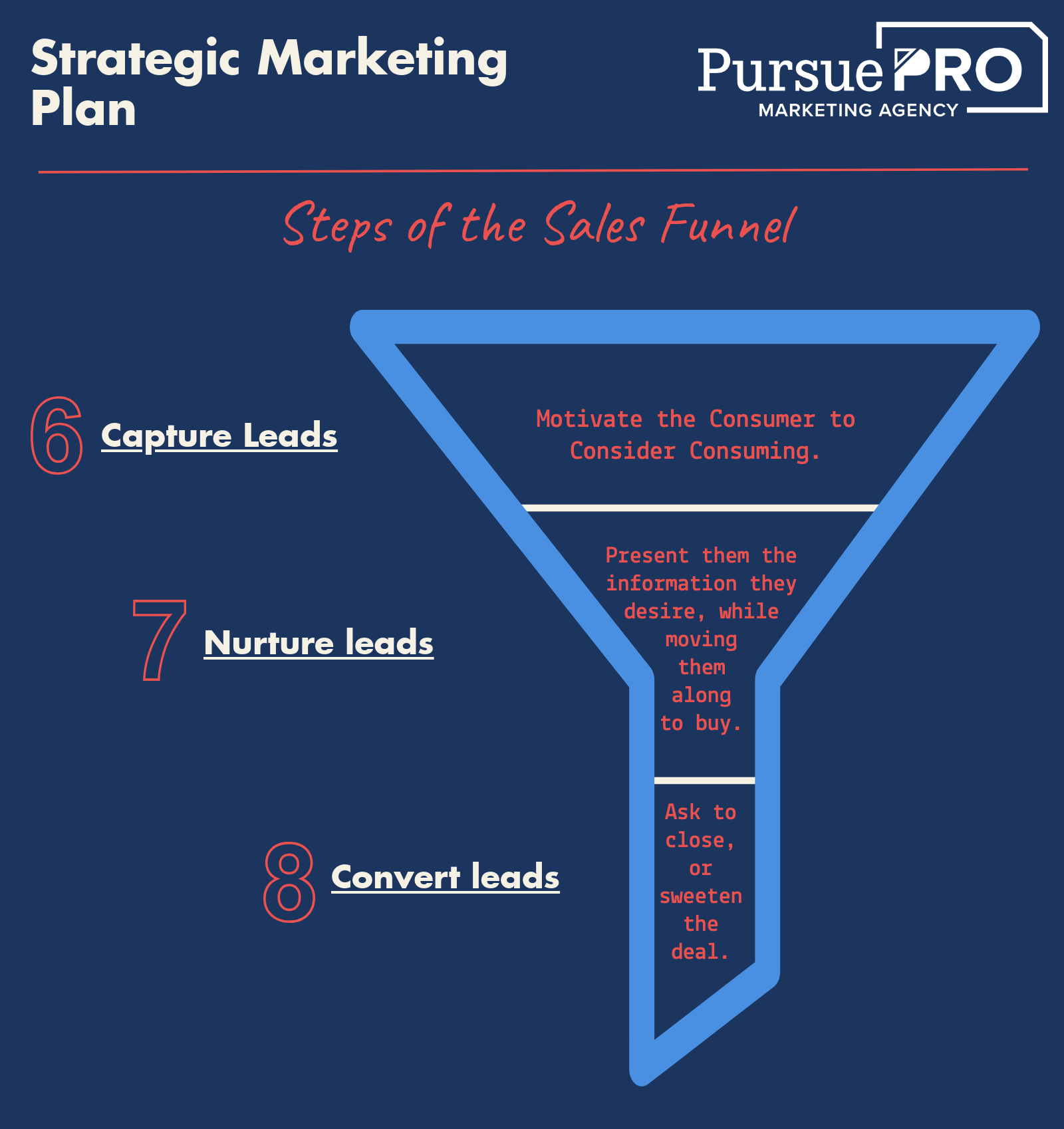
Sales Funnel:
This stage is all about how you capture, nurture, and convert leads. You should make sure all your campaigns are documented and supporting each other. Often times CRM software and other tools are used to easily streamline this part of your plan. You should be reworking your sales funnel as you continue to market your business over time. Other areas tend to change less often than your sales funnel will.
6. List out the tools you will use to Capture Leads and draw people into the sales funnel.
Sometimes the sales funnel (capture>nurture> convert) will happen very quickly, and sometimes it takes a long time. In most cases, the higher the price tag, the slower the process takes. Either way you must capture the lead to begin the process. In order to capture a lead, you must motivate the consumer to consider consuming. The worm on the end of your hook better be enticing enough to draw the fish in closer. In other words, your message that you came up with must be combined with one of your communication channels in order to catch your target market’s attention. While trying to capture a lead it is important to get some small, physical commitment of interest. For example this could be their email address to get more information or to schedule a meeting to discuss details. You can leverage more points of contact if you get this commitment. Psychologically, humans look to justify their own actions. By getting them to physically move toward purchasing your product or service, they will begin building an argument in your favor as to why they should buy. Once you have their interest, it is time to woo them into commitment.
7. List out the tools you will use to Nurture Leads.
Once you have the consumer’s attention, you must make the experience a positive one. For example, a good car salesperson will dote on you with coffee, treats, and pleasant conversation while you sit down to hear more about the new vehicle you are interested in. A key factor in nurturing a sale, is you want to make the information gathering and transaction steps as quick and painless as possible. You must provide a balance of details and speed. This step is just as important with digital advertising as it is personal selling. Once you get your customer to click on your social media ad, you must present them with the information they may desire, while moving them along to make the decision to buy. Because of this, landing pages have become a great tool to use with digital advertising.
Another way to look at lead nurturing is by creating multiple contact points for the consumer to be slowly convinced to buy. It is very common that consumers need to have multiple contacts with your product or service before they are convinced of purchasing. Many leads will walk away from your advertisement after showing interest, but if you manage to collect a way of reconnecting with them, your chances of converting are even better the second time.
8. Determine your Conversion Strategy to convert that lead into a sale.
If you have done your due diligence in determining what motivates your target market, your conversion strategy should be easy to identify. Most often, converting leads will happen organically if the capture and nurture process are effective. If they were, then all you have to do is ask to close the deal. But if they were not effective it is important to have one last offer in your back pocket. That last offer can be a price discount, added value, or something to sweeten the deal.
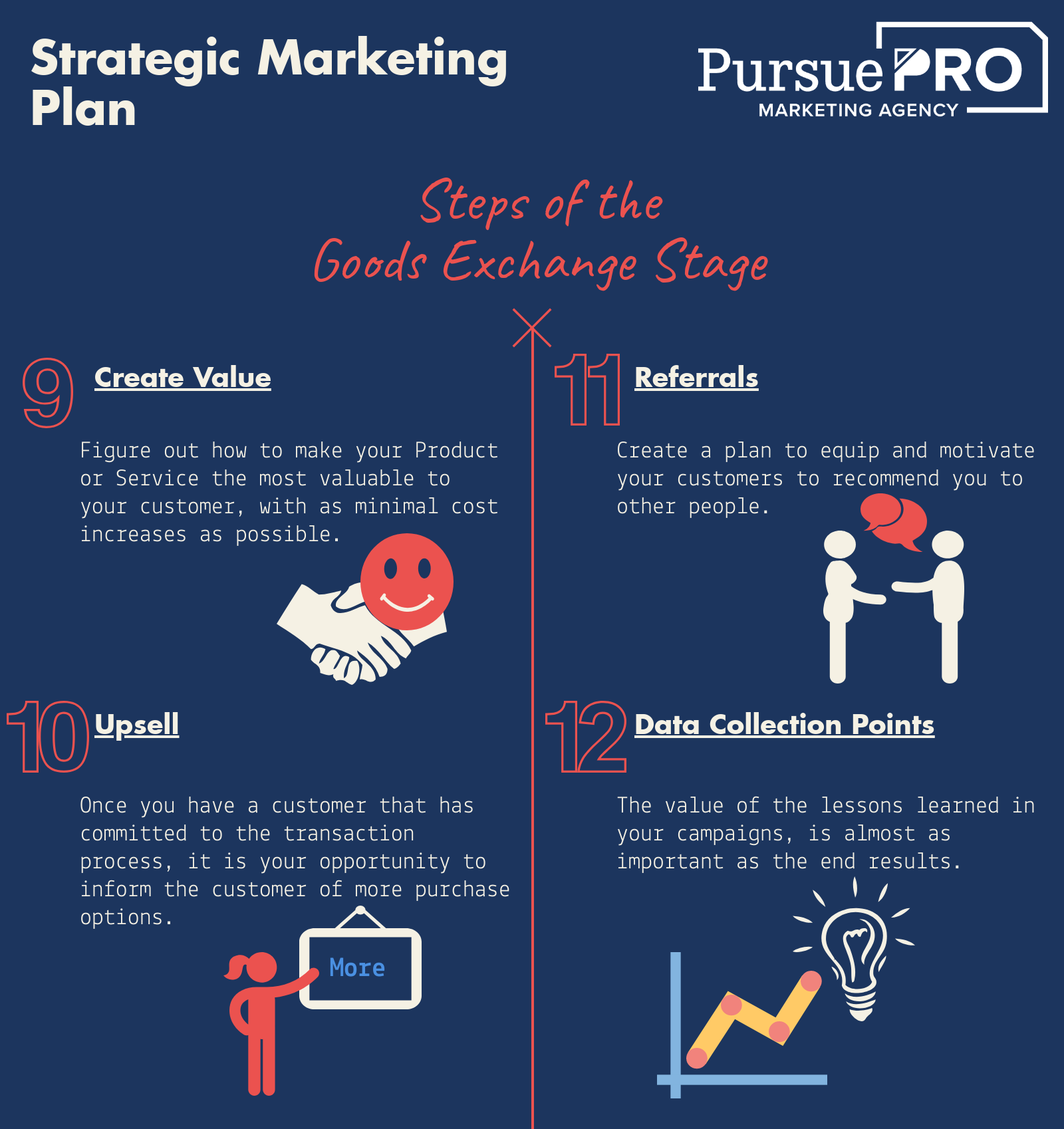
Goods Exchange Stage:
This stage is all about maximizing Customer Lifetime Value (CLV). Businesses often move on to the next potential customer as soon as they close a deal. By taking the time to create a plan to maximize CLV, you will increase your advertising ROI. Upselling and promotional offers for a repeat buy are the two most common ways to increase CLV. For example, gas stations often times offer you to wash your car for a discounted price while you are filling your tank. Additionally, many stores have discounts attached to receipts in order to get your repeat business. Increasing brand loyalty will also increase your CLV. By creating a brand that people start to adore, and creating a customer experience that makes them feel like part of a group, people will become advocates for your brand and will greatly increase their CLV.
9. Determine how you can Create Value-Add during the customer experience with your product or service.
To create more value-add to your customers, you need to figure out how to make your product or service more valuable with as minimal cost increases to you as possible. Most businesses underestimate the value of spending time to increase the value of their product without increasing their costs. Your success in beating your competition could come from the ways you innovate to create value-add in the customer experience.
Usually going above and beyond what is “expected” in the consumer experience, is how businesses achieve brand loyalty and repeat customers. Go the extra mile and add in small unexpected benefits in either your service or product. The minimal added cost to you could mean a world of difference to your customer. When your customer is taken by surprise with an added benefit it creates a feeling of joy and appreciation that can transform into loyalty.
For example, even an Italian restaurant can be seen as very elegant if the servers are dressed in fancy suits and dresses. The next door restaurant that serves the same quality italian food with casually dressed servers could receive very different reviews. The small details can create positive emotions towards businesses and ultimately create brand loyal customers that come back and spend more money later on.
10. Create a plan on how to Upsell.
Upselling is a widely used and very effective tactic to increase ROI of your advertising efforts. Once you have a customer that has committed to the transaction process, it is your opportunity to inform the customer of more purchase options. Why should you spend large amounts of money and effort to get the customer to buy from you only to miss your opportunity to inform them of more options to purchase at the point of the transaction. You don’t have to be pushy – you should try to maintain the good feeling you created in the sales funnel. Simply have a preplanned step to inform them of other purchase options. Don’t underestimate the effect on your sales this step can have. Make sure your formalize it and create a policy for your employees to follow.
11. Create a plan on how to get Referrals.
Referrals are the lifeblood of many businesses big and small. Generally, companies who are successful have either intentionally or unintentionally motivated their customers to refer them. You need to create a plan to equip and motivate your customers to recommend you to other people. For example, many businesses will offer incentives to refer your friends in the form of finders fees or discounts on future purchases.
You must get creative in coming up with ways to motivate your customer to refer you. Make it easy for them or make it incentivized. If you do an excellent job at providing value-add and an amazing customer experience, referrals will start happening by themselves. It is your job to maximize referrals by having a plan in place.
12. Develop a string of Data Collection Points throughout your sales funnel.
Data collection is a hugely overlooked part of advertising efforts that businesses rush past. All companies want to know the bottom line data point of how much sales increase there was, but ignore all the other points. Don’t spend your money on an advertising campaign if you don’t plan to learn how to make it better the next go round. The value of the lessons learned in your campaigns, is almost as important as the end results.
Make sure to integrate data collection in to every step of the process. Try A/B campaigns and continue to improve the way you advertise by looking at the data. Make your monetary advertising investment increase both your sales, and your knowledge about how to make better campaigns.
Our company name Pursue Pro was inspired by the idea of individuals pursuing professionalism through their marketing efforts, and continually aspiring to be the pro in their field.

Article written by Jacob Hirschman
